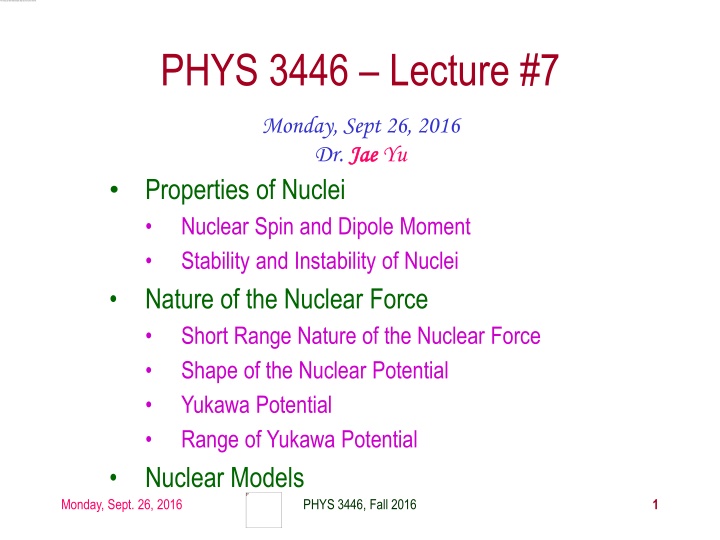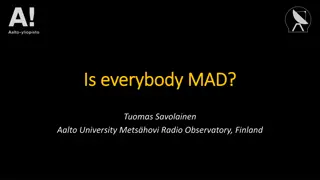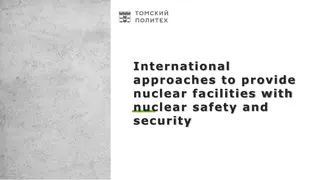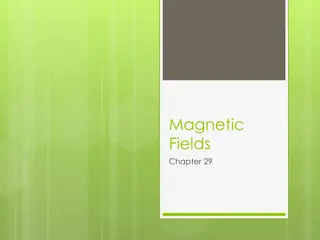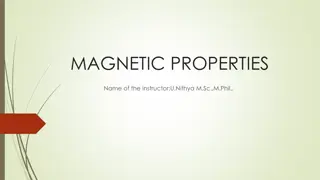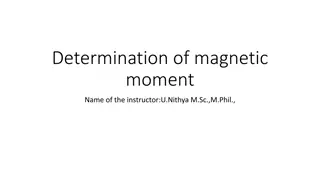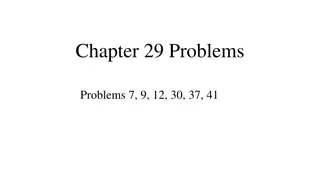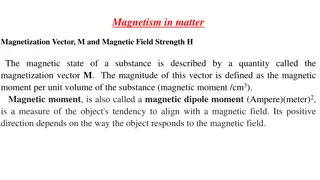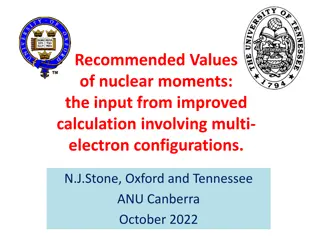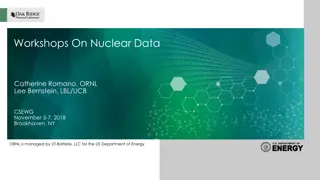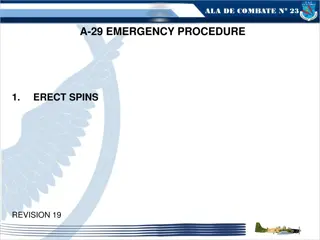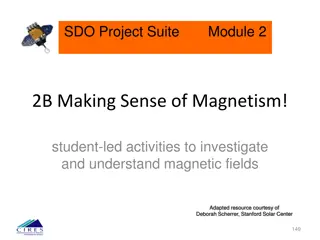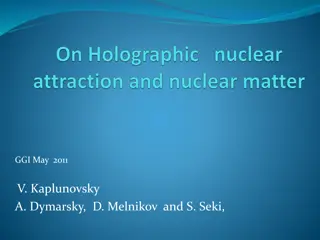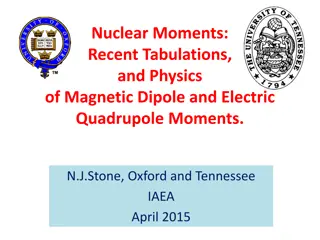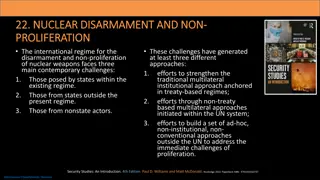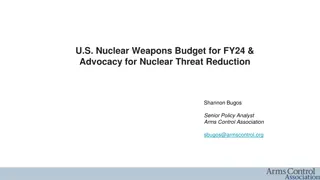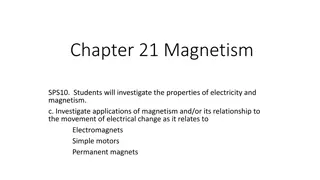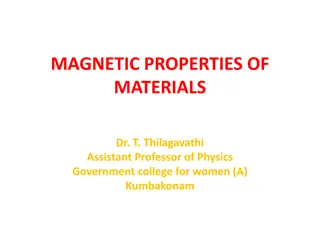Nuclear Properties: Spins, Magnetic Moments & Forces
Delve into the fascinating world of nuclear properties, exploring topics such as nuclear spins, magnetic dipole moments, stability, nuclear force nature, and more. Understand the intricate details of nuclei, from their spin behavior to magnetic properties, presented in a comprehensive and engaging manner. Dive into the complexities of nuclear models, force shapes, and potentials, gaining insights into the fundamental building blocks of matter.
Download Presentation

Please find below an Image/Link to download the presentation.
The content on the website is provided AS IS for your information and personal use only. It may not be sold, licensed, or shared on other websites without obtaining consent from the author.If you encounter any issues during the download, it is possible that the publisher has removed the file from their server.
You are allowed to download the files provided on this website for personal or commercial use, subject to the condition that they are used lawfully. All files are the property of their respective owners.
The content on the website is provided AS IS for your information and personal use only. It may not be sold, licensed, or shared on other websites without obtaining consent from the author.
E N D
Presentation Transcript
PHYS 3446 Lecture #7 Monday, Sept 26, 2016 Dr. Jae Jae Yu Properties of Nuclei Nuclear Spin and Dipole Moment Stability and Instability of Nuclei Nature of the Nuclear Force Short Range Nature of the Nuclear Force Shape of the Nuclear Potential Yukawa Potential Range of Yukawa Potential Nuclear Models Monday, Sept. 26, 2016 PHYS 3446, Fall 2016 1
Announcement First quiz Beginning of class Wednesday, Sept. 28 First term exam Date and time: 2:30 4:50pm, Monday, Oct. 10 Location: SH125 Covers: Ch 1 Ch 3 or what we finish Wednesday, Oct. 5, + Appendix A Colloquium Dr. Amir Farbin on Deep Learning Monday, Sept. 26, 2016 PHYS 3446, Fall 2016 2
Monday, Sept. 26, 2016 PHYS 3446, Fall 2016 3
Homework Assignment #4 1. Compute the mass density of a nucleus (10points) Pick two nuclei for this. I would like you guys to do different ones. 2. Compute the de Broglie wavelengths for (15 points) Protons in Fermilab s Tevatron Collider Protons in CERN s Large Hadron Collider (LHC) 500 GeV electrons in the International Linear Collider 3. Compute the actual value of the nuclear magneton (5 points) Due for the above is next Monday, Oct. 3 Monday, Sept. 26, 2016 PHYS 3446, Fall 2016 4
Nuclear Properties: Spins 1 2! Both protons and neutrons are fermions with intrinsic spin Nucleons inside a nucleus can have orbital angular momenta In Quantum Mechanics orbital angular momenta are integers Thus the total angular momentum (vector sum of orbital and intrinsic momenta of all constituents) of a nucleus is Integers: if even number of nucleons in the nucleus Half integers: if odd number of nucleons in the nucleus Interesting facts are All nucleus with even number of p and even n are spin 0. Large nuclei have very small spins in their ground state Hypothesis: Nucleon spins in a nucleus are very strongly paired to minimize their overall effect (entropy) Monday, Sept. 26, 2016 PHYS 3446, Fall 2016 5
Nuclear Properties: Magnetic Dipole Moments Every charged particle has a magnetic dipole moment associated with its spin ! S e ! m = g 2mc e, m and S are the charge, mass and the intrinsic spin of the charged particle The constant g is called Land factor with its value: : for a point like particle, such as the electron : Particle possesses an anomalous magnetic moment, an indication of having a substructure g = 2 g 2 Monday, Sept. 26, 2016 PHYS 3446, Fall 2016 6
Nuclear Properties: Magnetic Dipole Moments For electrons, e~ B, where B is Bohr Magneton of a point-like particle = 11 5.79 10 MeV/T B For nucleons, magnetic dipole moment is measured in nuclear magneton, defined using proton mass Measured magnetic moments of proton and neutron: 2.79 p N 1.91 n N
Nuclear Properties: Magnetic Dipole Moments What important information do you get from these? The Land factors of the nucleons deviate significantly from 2. Strong indication of substructure An electrically neutral neutron has a significant magnetic moment Must have extended charge distributions Measurements show that magnetic moment of nuclei lie -3 N~10 N Indication of strong pairing Electrons cannot reside in nucleus ( e~ B~2000 N) Monday, Sept. 26, 2016 PHYS 3446, Fall 2016 8
Nuclear Properties: Stability The number of protons and neutrons inside the stable nuclei are A<40: Equal (N=Z) A>40: N~1.7Z Neutrons outnumber protons Most are even-p + even n N~1.7Z N Z Nnucl 156 48 Even Even Even Odd N=Z Odd Even 50 Odd Odd 5 See table 2.1 Supports strong pairing Monday, Sept. 26, 2016 PHYS 3446, Fall 2016 9
Nuclear Properties: Instability In 1896 H. Becquerel accidently discovered natural radioactivity Study of Uranium salts fluorescent properties Nuclear radio activity involves emission of three radiations: and These can be characterized using the device on the right : Nucleus of He (v~0.1c), short range (a sheet of paper can stop it) : electrons (v<0.99c), has longer range and produces less ionization than can be stopped by 3mm lead : photons, long range, few cm lead to stop What do you see from above? and are charged particles while is neutral. is mono-energetic has broad spectrum What else could you see? Monday, Sept. 26, 2016 PHYS 3446, Fall 2016 10
Nature of the Nuclear Force Scattering experiments help to Determine the properties of nuclei Learn more global information on the characteristics of the nuclear force From what we have learned, it is clear that there is no classical analog to nuclear force Gravitational force is too weak to provide the binding Can t have an electromagnetic origin Deuteron nucleus has one neutron and one proton Coulomb force would destabilize the nucleus Monday, Sept. 26, 2016 PHYS 3446, Fall 2016 11
Short-range Nature of the Nuclear Force Atomic structure is well explained by the electromagnetic interaction Thus the range of nucleus cannot be much greater than the radius of the nucleus Nuclear force should range ~ 10-13 10-12cm Binding energy is constant per each nucleon, essentially independent of the size of the nucleus If the nuclear force is long-ranged, like the Coulomb force For A nucleons, there would be A(A-1) pair-wise interactions Thus, the BE which reflects all possible interactions among the nucleons would grow as a function of A ( 1) B A A For large A B A A Monday, Sept. 26, 2016 PHYS 3446, Fall 2016 12
Short-range Nature of the Nuclear Force If the nuclear force is long-ranged and is independent of the presence of other nucleons, BE per nucleon will increase linearly with A This is because long-range forces do not saturate Since any single particle can interact with as many other particle as are available Binding becomes tighter as the number of interacting objects increases The size of the interacting region stays fairly constant Atoms with large number of electrons have the sizes compatible to those with smaller number of electrons Monday, Sept. 26, 2016 PHYS 3446, Fall 2016 13
Short-range Nature of the Nuclear Force Long-rangeness of nuclear force is disputed by the experimental measurement that the BE/nucleon stays constant Nuclear force must saturate Any given nucleon can only interact with a finite number of nucleons in its vicinity What does adding more nucleons to a nucleus do? Only increases the size of the nucleus Recall that R ~ A1/3 The size of a nucleus grows slowly with A and keeps the nuclear density constant Another supporting evidence of short-range nature of nuclear force Monday, Sept. 26, 2016 PHYS 3446, Fall 2016 14
Shape of the Nuclear Potential Nuclear force keeps the nucleons within the nucleus. What does this tell you about the nature of the nuclear force? It must be attractive!! However, scattering experiments with high energy revealed a repulsive core!! Below a certain length scale, the nuclear force changes from attractive to repulsive. What does this tell you? Nucleons have a substructure . This feature is good, why? If the nuclear force were attractive at all distances, the nucleus would collapse in on itself. Monday, Sept. 26, 2016 PHYS 3446, Fall 2016 15
Shape of the Nuclear Potential We can turn these behaviors into a square- well potential For low energy particles, the repulsive core can be ignored, why? Can t get there.. This model is too simplistic, since there are too many abrupt changes in potential. There would be additional effects by the Coulomb force Attractive force Repulsive Core Monday, Sept. 26, 2016 PHYS 3446, Fall 2016 16
Nuclear Potential w/ Coulomb Corrections Results in Classically an incident proton with total energy E0 cannot be closer than r=r0. Why? For R<r<r0, V(r) >E0 and KE<0 Physically impossible What about a neutron? Could penetrate into the nuclear center. Low energy scattering experiment did not provide the exact shape of the potential but the range and height of the potential The square-well shape provides a good phenomenological description of the nuclear force. Monday, Sept. 26, 2016 PHYS 3446, Fall 2016 17
Nuclear Potential A square well nuclear potential provides the basis of quantum theory with discrete energy levels and corresponding bound state just like in atoms Presence of nuclear quantum states have been confirmed through Scattering experiments Studies of the energies emitted in nuclear radiation Studies of mirror nuclei and the scatterings of protons and neutrons demonstrate Without the Coulomb effects, the forces between two neutrons, two protons or a proton and a neutron are the same Nuclear force is independent of electrical charge Protons and neutrons behave the same under the nuclear force Inferred as charge independence of nuclear force. Monday, Sept. 26, 2016 PHYS 3446, Fall 2016 18
Nuclear Potential Iso-spin symmetry Strong nuclear force is independent of the electric charge carried by nucleons Concept of strong isotopic-spin symmetry. proton and neutron are the two different iso-spin state of the same particle called nucleon In other words, If the Coulomb effect were turned off, protons and neutrons would be indistinguishable in their nuclear interactions Can you give another case just like this??? This is analogues to the indistinguishability of spin up and down states in the absence of a magnetic field!! This is called Iso-spin symmetry!!! Monday, Sept. 26, 2016 PHYS 3446, Fall 2016 19
Range of the Nuclear Force EM force can be understood as a result of a photon exchange Photon propagation is described by the Maxwell s equation Photons propagate at the speed of light. What does this tell you about the mass of the photon? Massless Coulomb potential is V r 1 ( ) Massless particle exchange r What does this tell you about the range of the Coulomb force? Long range. Why? Monday, Sept. 26, 2016 PHYS 3446, Fall 2016 20
Yukawa Potential For massive particle exchanges, the potential takes the form ( ) r -mc !r e V r What is the mass, m, in this expression? Mass of the particle exchanged in the interaction The force mediator mass This form of potential is called Yukawa Potential Formulated by Hideki Yukawa in 1934 What does Yukawa potential turn to in the limit m 0? Coulomb potential Monday, Sept. 26, 2016 PHYS 3446, Fall 2016 21
Ranges in Yukawa Potential From the form of the Yukawa potential -mc !r =e-r ! V r ( ) e r r The range of the interaction is given by some characteristic value of r. What is this? Compton wavelength of the mediator with mass, m: What does this mean? Once the mass of the mediator is known, range can be predicted Once the range is known, the mass can be predicted " ! = mc Monday, Sept. 26, 2016 PHYS 3446, Fall 2016 22
Ranges in Yukawa Potential Let s put Yukawa potential to work What is the range of the nuclear force? About the same as the typical size of a nucleus 1.2x10-13cm thus the mediator mass is 197 MeV fm !c " 2 = 164 MeV mc 1.2 fm This is close to the mass of a well known meson (pion) 2 2 m = = m += 139.6 / ; 135 / MeV c m MeV c 0 Thus, it was thought that are the mediators of the nuclear force Monday, Sept. 26, 2016 PHYS 3446, Fall 2016 23
